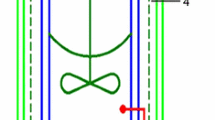Abstract
The metal binding ability of Maillard reaction products (MRP) was investigated by spectrophotometric monitoring for complex/chelate formation. In addition, the antioxidant activity of MRP, in the presence of Cu(II), was evaluated on a lipid model system consisting of sunflower seed oil/water (1∶2). Results from the Rancimat test indicated a significant decrease in pro-oxidant ability of Cu(II) in the presence of MRP in contrast to histidine alone, whether heated or not. Results from the diphenylpicrylhydrazyl method showed that, in contrast to histidine (heated or not), the antiradical ability of MRP is reduced in the presence of Cu(II), but depends on the reaction time between MRP and Cu(II).
Similar content being viewed by others
References
Eichner, K., Antioxidative Effect of Maillard Reaction Intermediates, Prog. Food Nutr. Sci. 5:441–451 (1981).
Lingnert, H., and C.E. Eriksson, Antioxidative Effect of Maillard Reaction Products, —Ibid. 5:453–466 (1981).
Hayase, F., S. Hirashima, G. Okamoto, and H. Kato, Scavenging of Active Oxygens by Melanoidins, Agric. Biol. Chem. 53:3383–3385 (1989).
Yen, G.-C., and P.-P. Hsieh, Antioxidative Activity and Scavenging Effects on Active Oxygen of Xylose-Lysine Maillard Reaction Products, J. Sci. Food Agric. 67:415–420 (1995).
Yoshimura, Y., T. Iijima, T. Watanabe, and H. Nakazawa, Antioxidative Effect of Maillar Reaction Products Using Glucose-Glycine Model System, J. Agric. Food Chem. 45: 4106–4109 (1997).
Hashiba, H., Oxidative Browning of Amadori Compounds. Color Formation by Iron with Maillard Reaction Products, Dev. Food Sci. 13:155–164 (1986).
O'Brien, J., and P.A. Morrissey, Metal Ion Complexation By-Products of the Maillard Reaction, Food Chem. 58:17–27 (1997).
Wijewickreme, A.N., D.D. Kitts, and T.D. Durance, Reaction Conditions Influence the Elementary Composition and Metal Chelating Affinity of Nondialyzable Model Maillard Reaction Products, J. Agric. Food Chem. 45:4577–4583 (1997).
Yen, G.-C., and M.-L. Liu, Antioxidative and Prooxidative Actions of Xylose-Lysine Maillard Reaction Products, Biosci. Biotechnol. Biochem. 62:864–869 (1998).
Namiki, M., Chemistry of Maillard Reactions: Recent Studies on the Browning Reaction Mechanism and the Development of Antioxidants and Mutagens, Adv. Food Res. 32:115–184 (1988).
Bersuder, P., M. Hole, and G. Smith, Antioxidants from a Heated Histidine-Glucose Model System. I: Investigation of the Antioxidant Role of Histidine and Isolation of Antioxidants by High-Performance Liquid Chromatography, J. Am. Oil Chem. Soc. 75:181–187 (1998).
Waters, L., Lipid Oxidation in Salted-Dried Pelagic Fish, Ph.D. Thesis, University of Humberside, United Kingdom, 1995, 75 pp.
British Standards Institution, Methods of Analysis of Fats and Fatty Oils, Other Methods, Determination of Peroxide Value, BS 684 Part 2: Section 2. 14:1–6 (1987).
Kurechi, T., K. Kikugawa, and T. Kato, Studies on the Antioxidants. XIII. Hydrogen-Donating Capability of Antioxidants to 2,2-Diphenyl-1-picrylhydrazyl, Chem. Pharm. Bull. 28: 2089–2093 (1980).
Brand-Williams, W., M.E. Cuvelier, and C. Berset, Use of a Free Radical Method to Evaluate Antioxidant Activity, Lebensm. Wiss. Technol. 28:25–30 (1995).
Vogel, A., Vogel's Practical Organic Chemistry, Including Qualitative Organic Analysis, 4th edn., Longman Group Ltd., London, 1978, p. 435.
Farag, R.S., S.A. Osman, S.A.S. Hallabo, A.N. Girgis, and A.A. Nasi, Linoleic Acid Oxidation Catalyzed by Various Amino Acids and Cupric Ions in Freeze-Dried Model Systems, J. Am. Oil Chem. Soc. 55:703–707 (1978).
Farag, R.S., S.A. Osman, S.A.S. Hallabo, and A.A. Nasr, Linoleic Acid Oxidation Catalyzed by Various Amino Acids and Cupric Ions in Aqueous Media, —Ibid. 55:708–710 (1978).
Marcuse, R., Autoxydation des Lipides. II. Etude de Paramètres Intervenant dans l'Oxydation Lipidique, Rev. Franç. Corps Gras 20:391–396 (1973).
Riisom, T., R.J. Sims, and J.A. Fioriti, Effect of Amino Acids on the Autoxidation of Safflower Oil in Emulsions, J. Am. Oil Chem. Soc. 57:354–359 (1980).
Author information
Authors and Affiliations
Corresponding author
About this article
Cite this article
Bersuder, P., Hole, M. & Smith, G. Antioxidants from a heated histidine-glucose model system. Investigation of the copper(II) binding ability. J Amer Oil Chem Soc 78, 1079–1082 (2001). https://doi.org/10.1007/s11746-001-0392-y
Received:
Accepted:
Issue Date:
DOI: https://doi.org/10.1007/s11746-001-0392-y




